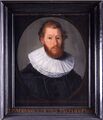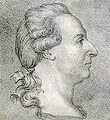Template:Selected anniversaries/September 6: Difference between revisions
No edit summary |
No edit summary |
||
| Line 1: | Line 1: | ||
<gallery> | <gallery> | ||
||1492 | ||1492: Christopher Columbus sails from La Gomera in the Canary Islands, his final port of call before crossing the Atlantic Ocean for the first time. | ||
||1522 | ||1522: The Victoria, the only surviving ship of Ferdinand Magellan's expedition, returns to Sanlúcar de Barrameda in Spain, becoming the first ship to circumnavigate the world. | ||
File:Adriaan Metius.jpg|link=Adriaan Metius (nonfiction)|1635: Mathematician and astronomer [[Adriaan Metius (nonfiction)|Adriaan Metius]] dies. He manufactured precision astronomical instruments, and published treatises on the astrolabe and on surveying. | File:Adriaan Metius.jpg|link=Adriaan Metius (nonfiction)|1635: Mathematician and astronomer [[Adriaan Metius (nonfiction)|Adriaan Metius]] dies. He manufactured precision astronomical instruments, and published treatises on the astrolabe and on surveying. | ||
||Nehemiah Grew | ||1641: Nehemiah Grew born ... plant anatomist and physiologist, known as the "Father of Plant Anatomy". Pic. | ||
File:Ultravore.jpg|link=Ultravore|1765: Synthetic organism [[Ultravore]] exhibited in London for the first time, consuming several tons of coal ash and knackered horses. | File:Ultravore.jpg|link=Ultravore|1765: Synthetic organism [[Ultravore]] exhibited in London for the first time, consuming several tons of coal ash and knackered horses. | ||
||1649 | ||1649: Robert Dudley dies ... geographer and explorer. | ||
File:Johan Carl Wilcke.jpg|link=Johan Wilcke (nonfiction)|1732: Physicist and academic [[Johan Wilcke (nonfiction)|Johan Carl Wilcke]] born. He will invent the electrophorus, and calculate the latent heat of ice. | File:Johan Carl Wilcke.jpg|link=Johan Wilcke (nonfiction)|1732: Physicist and academic [[Johan Wilcke (nonfiction)|Johan Carl Wilcke]] born. He will invent the electrophorus, and calculate the latent heat of ice. | ||
| | ||1857: Johann Salomo Christoph Schweigger dies ... chemist, physicist, and professor of mathematics. | ||
| | File:John Dalton by Charles Turner.jpg|link=John Dalton (nonfiction)|1766: Chemist, meteorologist, and physicist [[John Dalton (nonfiction)|John Dalton]] born. He will propose the modern atomic theory, and do research in color blindness. | ||
File:John Dalton by Charles Turner.jpg|link=John Dalton (nonfiction)| | File:John Dalton by Charles Turner.jpg|link=John Dalton (nonfiction)|1803: British scientist [[John Dalton (nonfiction)|John Dalton]] begins using symbols to represent the atoms of different elements. | ||
|| | ||1828: Alexander Mikhaylovich Butlerov born ... chemist, one of the principal creators of the theory of chemical structure (1857–1861), the first to incorporate double bonds into structural formulas, the discoverer of hexamine (1859), the discoverer of formaldehyde (1859) and the discoverer of the formose reaction (1861). He first proposed the idea of possible tetrahedral arrangement of valence bonds in carbon compounds in 1862. Pic. | ||
||1838 | ||1838: Samuel Arnold dies ... American conspirator. | ||
||Dmitry Aleksandrovich Grave | ||1863: Dmitry Aleksandrovich Grave born ... mathematician. | ||
||Frederick George Donnan | ||1870: Frederick George Donnan born ... physical chemist who is known for his work on membrane equilibria, and commemorated in the Donnan equilibrium describing ionic transport in cells. Pic. | ||
||HMS Captain was an unsuccessful warship built for the Royal Navy due to public pressure. She was a masted turret ship, designed and built by a private contractor against the wishes of the Controller's department. The Captain was completed in April 1870 and capsized on September 6, 1870 with the loss of nearly 500 lives because of design and construction errors that led to inadequate stability. | ||1870: ''HMS Captain'' capsizes ... ''Captain'' was an unsuccessful warship built for the Royal Navy due to public pressure. She was a masted turret ship, designed and built by a private contractor against the wishes of the Controller's department. The ''Captain'' was completed in April 1870 and capsized on September 6, 1870 with the loss of nearly 500 lives because of design and construction errors that led to inadequate stability. | ||
||1885 | ||1885: Engineer and artist Narcís Monturiol dies. He invented the first air-independent and combustion-engine-driven submarine. | ||
|| | ||1892: Edward Victor Appleton born ... physicist, Nobel Prize winner (1947) and pioneer in radiophysics. Pic. | ||
||Major-General Dr. Walter Robert Dornberger | ||1895: Major-General Dr. Walter Robert Dornberger born ... German Army artillery officer whose career spanned World War I and World War II. He was a leader of Nazi Germany's V-2 rocket program and other projects at the Peenemünde Army Research Center. Pic. | ||
||1902 | ||1902: Frederick Abel born ... chemist and engineer ... explosives, smokeless powder, electrical fuses. | ||
||1906 | ||1906: Luis Federico Leloir born ... physician and biochemist, Nobel Prize laureate. | ||
||1921 | ||1921: Norman Joseph Woodland born ... inventor, co-created the bar code. | ||
||1929 | ||1929: Ljubov Rebane born ... physicist and mathematician. | ||
||1939 | ||1939: Susumu Tonegawa born ... biologist and immunologist, Nobel Prize laureate (alive August 2018). | ||
||1956 | ||1956: Witold Hurewicz, dies ... mathematician. No pic. | ||
||1962 | ||1962: The United States government begins the Exercise Spade Fork nuclear readiness drill. | ||
||1962 | ||1962: Archaeologist Peter Marsden discovers the first of the Blackfriars Ships dating back to the 2nd century AD in the Blackfriars area of the banks of the River Thames in London. | ||
||John Edensor Littlewood | ||1977: John Edensor Littlewood dies ... mathematician, best known for his achievements in analysis, number theory, and differential equations and for his long collaboration with G. H. Hardy. | ||
File:John Backus.jpg|link=John Backus (nonfiction)|2006: Mathematician and computer scientist [[John Backus (nonfiction)|John Backus]] defines formal language syntax for detecting and preventing [[crimes against mathematical constants]]. | File:John Backus.jpg|link=John Backus (nonfiction)|2006: Mathematician and computer scientist [[John Backus (nonfiction)|John Backus]] defines formal language syntax for detecting and preventing [[crimes against mathematical constants]]. | ||
| Line 60: | Line 60: | ||
File:Janet Beta at ENIAC.jpg|link=Janet Beta at ENIAC|2008: Steganographic analysis of ''[[Janet Beta at ENIAC]]'' reveals previously unknown [[cryptographic numen]]. | File:Janet Beta at ENIAC.jpg|link=Janet Beta at ENIAC|2008: Steganographic analysis of ''[[Janet Beta at ENIAC]]'' reveals previously unknown [[cryptographic numen]]. | ||
||Rita Harriet Harradence | ||2012: Rita Harriet Harradence dies ... biochemist who pioneered the synthesis of penicillamine and steroids, and the stereochemistry of molecules involved in the biosynthesis of cholesterol. Pic. | ||
||2017 | ||2017: Lotfi Zadeh dies ... mathematician and computer scientist and founder of fuzzy logic. https://www.nytimes.com/2017/09/11/science/lotfi-zadeh-father-of-mathematical-fuzzy-logic-dies-at-96.html | ||
File:Cryptographic numen modelled as nano-wire.jpg|link=Cryptographic numen|2017: Previously unknown type of [[cryptographic numen]] revealed by steganographic analysis of ''[[Janet Beta at ENIAC]]''. | File:Cryptographic numen modelled as nano-wire.jpg|link=Cryptographic numen|2017: Previously unknown type of [[cryptographic numen]] revealed by steganographic analysis of ''[[Janet Beta at ENIAC]]''. | ||
</gallery> | </gallery> | ||
Revision as of 10:35, 15 August 2018
1635: Mathematician and astronomer Adriaan Metius dies. He manufactured precision astronomical instruments, and published treatises on the astrolabe and on surveying.
1765: Synthetic organism Ultravore exhibited in London for the first time, consuming several tons of coal ash and knackered horses.
1732: Physicist and academic Johan Carl Wilcke born. He will invent the electrophorus, and calculate the latent heat of ice.
1766: Chemist, meteorologist, and physicist John Dalton born. He will propose the modern atomic theory, and do research in color blindness.
1803: British scientist John Dalton begins using symbols to represent the atoms of different elements.
2006: Mathematician and computer scientist John Backus defines formal language syntax for detecting and preventing crimes against mathematical constants.
2007: Writer Madeleine L'Engle dies. She wrote the Newbery Medal-winning A Wrinkle in Time and its sequels.
2008: Steganographic analysis of Janet Beta at ENIAC reveals previously unknown cryptographic numen.
2017: Previously unknown type of cryptographic numen revealed by steganographic analysis of Janet Beta at ENIAC.







